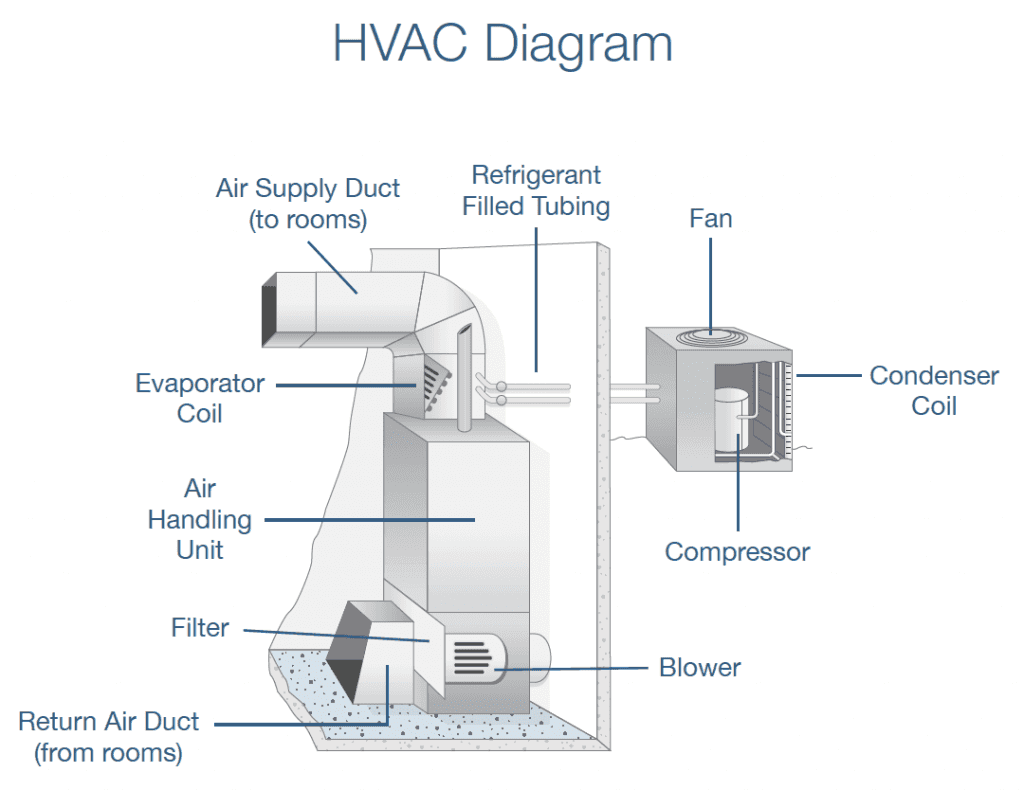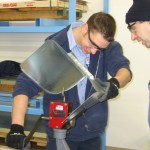What should you know about HVAC replacement costs?
Replacing HVAC equipment is not something that homeowners have to do often. In fact, most Twin Cities homeowners go through this process once or twice in their entire life. For this reason, when it comes to furnace or air conditioner prices, most of us have no idea how much money it will take to replace the old furnace and/or air conditioner with a brand-new system.
Here are the steps that we advise you to take to understand HVAC replacement costs:
1 – Start by understanding your current system
Many modern homes in the twin cities are heated and cooled by a gas-forced air furnace and central air conditioner respectively. If that’s not the case for your home, visit our Heating and Cooling options page to learn more about other alternatives.
Here is a graph of a gas-forced air and air conditioner system (click on the image to learn more):
 Source: Angie’s List
Source: Angie’s List
Air Conditioner Equipment
The outdoor condenser unit is not the only part of your A/C. The air conditioning system includes the following components:
- Evaporator Coil: In a system with a furnace, the evaporator coil sits on top of the furnace and is the critical component that cools the air inside a home. The furnace blower passes air across the evaporator coil. During this process, the air cools as it comes in contact with the cold coil, and heat transfers from the air to the refrigerant.
- Condenser Coil: This part of the air conditioning system cools (removes heat) from refrigerant and is located in the outdoor condenser unit.
- Compressor: A machine used to supply air or other gas at increased pressure, located in the outdoor condenser unit.
- Fan: A mechanical device that creates a current of air.
- Refrigerant Filled Tubing: Circulates refrigerant between outdoor condenser unit and indoor evaporator coil.
Gas Forced Air Furnace Equipment
- Return Air Duct (from rooms): A duct carrying air from a conditioned space to the mixing air duct or plenum unit.
- Filter: A porous device for removing impurities or solid particles from the air that passes through it.
- Blower: a mechanical device that creates a current of air. See fan also.
- Air Handling Unit (AHU): a device used to condition and circulate air as part of a heating, ventilating, and air-conditioning (HVAC) system. An air handler is usually a large metal box containing a blower, heating or cooling elements, filter racks or chambers, sound attenuators, and dampers. Air handlers usually connect to a ductwork ventilation system that distributes the conditioned air through the building and returns it to the AHU.
- Air Supply Duct (to rooms): A duct that carries conditioned air from air supply units to room diffusers or grilles.
2 – Make sure you need a new one
There are signs that indicate that it could be a good time to consider replacing your heating and cooling equipment and improving the performance of your overall air indoor quality system (List by ENERGY STAR):
• Your heat pump or air conditioner is more than 10 years old.
• Your furnace or boiler is more than 15 years old.
• Your equipment needs frequent repairs and your energy bills are going up.
• Some rooms in your home are too hot or too cold, creating uneven airflow.
• No one is home for long periods of the day and you do not have a programmable thermostat.
• Your home has humidity problems.
• Your home has excessive dust.
• Your heating or cooling system is noisy.
To learn more about these signs, visit our Ask The Expert page
Lastly, if you had a contractor service your equipment and they said you needed new equipment, make sure to get a second opinion from a trustworthy company like Standard Heating.
3- Don’t trust everything you read on the Internet
 There are websites out there that quote prices of furnaces and A/Cs online without telling you the complete story. The reality is they won’t be installing the equipment, or standing behind their words. These websites are just trying to get your contact information to sell your need as a lead to local HVAC companies that will pay from $50 to $500 for it. Examples of those websites are Quality Smith, Home WYSE, eHow, Furnace Price Guides, Furnace Compare, and others. The anonymity of the Internet might not be your best friend in this process; talk to real experts.
There are websites out there that quote prices of furnaces and A/Cs online without telling you the complete story. The reality is they won’t be installing the equipment, or standing behind their words. These websites are just trying to get your contact information to sell your need as a lead to local HVAC companies that will pay from $50 to $500 for it. Examples of those websites are Quality Smith, Home WYSE, eHow, Furnace Price Guides, Furnace Compare, and others. The anonymity of the Internet might not be your best friend in this process; talk to real experts.
Subsequently, you can’t trust all online reviews and testimonials. In fact, a professor of computer science at the University of Illinois estimates that as many as 30 percent of online reviews are fake (Wall Street Journal, ABCnews, NYTimes. That is why we decided to raise the standard by sharing all reviews with you. Click on Testimonials to read unfiltered and unbiased reviews!
4 – Learn about the variables that influence the cost of HVAC replacement
Here are the variables that you have to consider:
- Size of equipment: the price of a furnace and/or air conditioner varies with the size of the equipment. The size of the equipment is measured in BTUs (British Thermal Units).
- Kind of equipment:
- Efficiency levels: Measured by AFUE (Annual Fuel Utilization Efficiency) and SEER (Seasonal Energy Efficiency Ratio)
- Kind of Speed Blower: Single-stage, two-stage, or variable speed
- Expected Noise-levels: There are differences in the noise levels from different models and brands of equipment as well as from the proper installation.
• Equipment versus installation: The majority of the total price of the work will go to the installation and not to the equipment itself; that’s what you have to spend the most time on.
• Geography: There are different regulations/codes across the country and even among the ordinances/codes.
• Retrofitting versus new construction installation
• Time of the year: Take advantage of the seasonal offers!
Anyone who gives you a price for the replacement of HVAC equipment via phone or email without analyzing your home and situation may at least be misleading you. It is almost impossible to know what it will take to replace your furnace or air conditioning with a new unit because there are so many variables to take into consideration. It is best to hire honest professionals that will do an expert job at a competitive price.
5 – Make sure to ask informed questions to the person that comes for an in-home estimate
EQUIPMENT
• Will you measure my home and calculate the correct size for my equipment using the Air Conditioning Contractors of America (ACCA) Manual J or equivalent?
• Will you install a properly matched indoor coil and outdoor unit? (AC & heat pump only) Your contractor should provide an Air Conditioning, Heating, and Refrigeration Institute (AHRI) certificate to document that your system was properly matched.
• Will you test to determine the maximum system size that can be installed with my existing ductwork?
• Will you install new refrigerant lines rather than reusing existing lines?
• Will you consider if zoning, with separate temperature controls for different areas, would be appropriate for my home?
• Will you provide me with information on any local rebate programs for which I might be eligible?
DUCTWORK

• Will you check for damage to existing ductwork and duct insulation, and make repairs if necessary?
• If insulating ducts, will you seal all duct seams first?
• Will you test to confirm that duct leakage does not exceed recommended levels? Duct sealing is essential to the operation of your heating and cooling system. In most cases, it is recommended that total duct leakage be no more than 20%.
VERIFICATION & MAINTENANCE
• After installation, will you leave all manuals with me and provide documentation of installation procedures, including Manual J calculations, AHRI certificate, and records of any measurements or testing?
• Do you offer third-party verification that my system was properly installed and set up?
• Will you confirm proper levels of refrigerant and airflow across the coil? (AC & heat pump only)
Once you understand your heating and cooling system and confirm that you need new HVAC equipment, take into consideration all the variables that affect the cost of replacement and make sure you are asking all the right questions. By doing that, you will ensure a satisfactory process, so you can worry less and live more. For further reading, learn more about the 5 typical misconceptions when buying new HVAC equipment.
Minneapolis Location
| (612) 324-1015 | |
| Schedule an Appointment | |
Saint Paul Location
| (612) 324-1015 | |
| Schedule an Appointment | |

